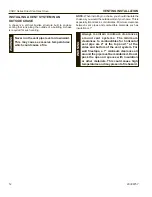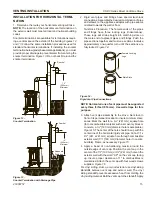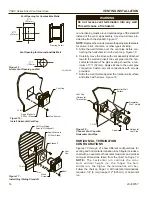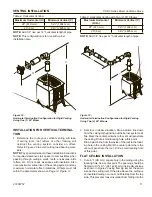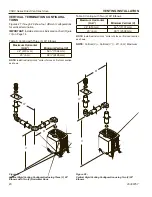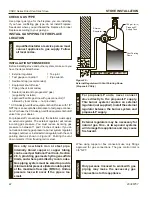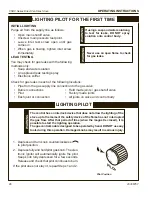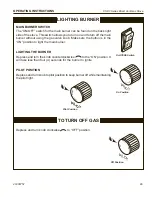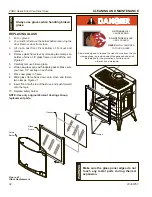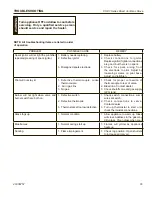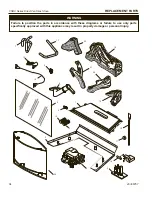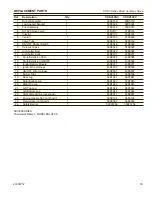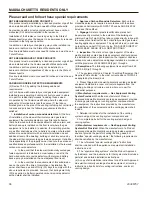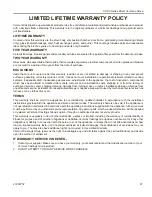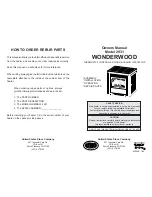
20306757
23
CSDV Series Direct Vent Gas Stove
STOVE INSTALLATION
NOTE :
The gas line connection may be made using 1/2"
rigid tubing or an approved flex connector. Since some
municipalities have additional local codes it is always best
to consult your local authorities and the current edition of
the National Fuel Gas Code ANSI.Z223.1, NFPA54. In
Canada CSA-B149 (1 or 2) Installation Code.
A listed manual shutoff valve must be installed upstream of
the appliance. Union tee and plugged 1/8" NPT pressure
tapping point should be installed upstream of the appliance.
Figure 31
IMPORTANT:
Install main gas valve (equipment shutoff
valve) in an accessible location. The main gas valve is for
turning on or shutting off the gas to the fireplace.
Check your building codes for any special requirements for
locating equipment shutoff valve to fireplaces.
Apply pipe joint sealant lightly to male threads. This will
prevent excess sealant from going into pipe. Excess seal-
ant in pipe could result in clogged burner system valves.
Figure 31 -
Gas Connection
3" Minimum
FP1978
gas connection
Pipe Nipple
Cap
Tee Joint
Approved
Flexible
Gas Line
CSA Design-Certified
Equipment Shutoff
Valve with 1/8" NPT
Tap*
Sediment Trap/
Drip Leg
Natural Gas
From Gas Meter
(5.0" w.c. to 10.5" w.c. Pressure)
Propane/LP
From External Regulator
(11,0" w.c. to 13.0" w.c. Pressure)
A manual shutoff valve must be installed
upstream of the appliance. Union tee and
plugged 1/8" NPT pressure tapping point should
be installed upstream of the appliance.
Figure 31
CAUTION
We recommend that you install a sediment trap/drip leg in
supply line as shown in
Figure 31
. Locate sediment trap/
drip leg where it is within reach for cleaning. Install in piping
system between fuel supply and burner system. Locate
sediment trap/drip leg where trapped matter is not likely to
freeze. A sediment trap traps moisture and contaminants.
This keeps them from going into the burner system gas con
-
trols. If sediment trap/drip leg is not installed or is installed
wrong, burner system may not run properly.
CHECK GAS PRESSURE
1. Check gas type. The gas supply must be the same as
stated on the appliance’s rating decal. If the gas supply
is different from the fireplace,
STOP!
Do not install the
appliance. Contact your dealer immediately.
2. To ease installation, a 30" (mm) flex line with manual
shut-off valve has been provided with on this appliance.
Install and attach 1/2" gas line onto shut-off valve.
3. After completing gas line connection, purge air from
gas line and test all gas joints from the gas meter to the
fireplace for leaks. Use a solution of 50/40 water and
soap or a gas sniffer.
4. To adjust flame height, turn HI/LO knob to HI to get
maximum pressure to burner. Turn HI/LO knob to LO
to get minimum pressure.
5. To check gas pressures at valve, turn captured screw
counter clockwise 2 or 3 turns and then place tubing
to pressure gauge over test point. Turn unit to high.
Figure 32.
After taking pressure reading, be sure and
turn captured screw clockwise firmly to reseal. Do not
over torque. Check test points for gas leaks.
Use pipe joint sealant that is resistant to liquid
petroleum (LP) gas.
CAUTION
Figure 32 -
Gas Pressure Check at Gas Valve
FP1979
Millivolt gas valve
Pressure
Test “IN”
Pressure
Test “OUT”
HI/LO Knob
Pilot Adjustment Screw




